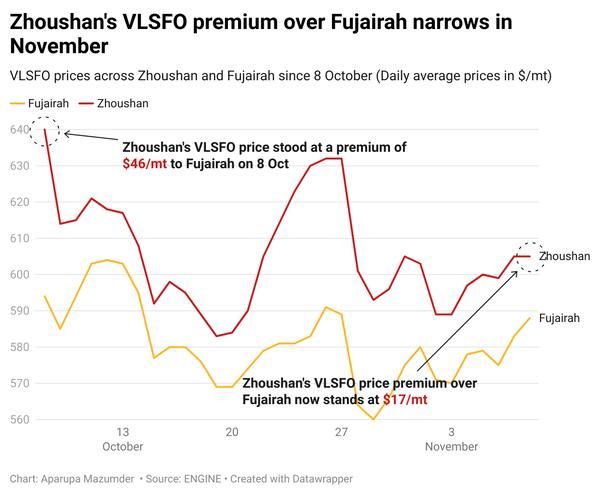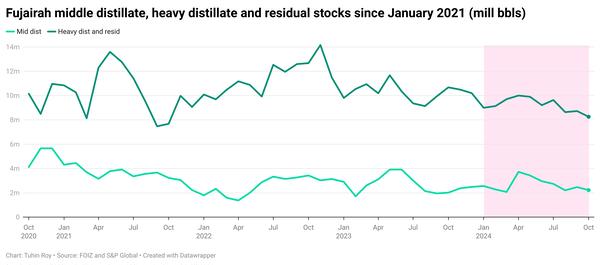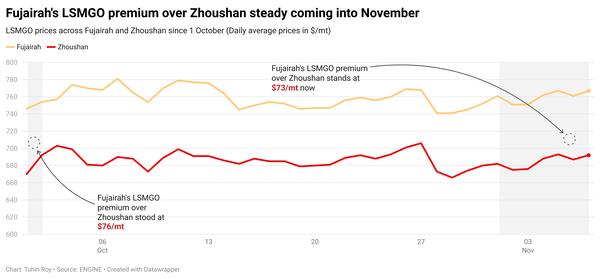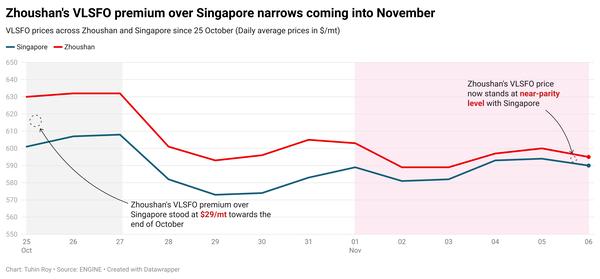East of Suez Market Update 20 Sep 2024
Regional bunker benchmarks have moved in mixed directions, and VLSFO availability has improved in Zhoushan.

Changes on the day to 17.00 SGT (09.00 GMT) today:
- VLSFO prices up in Fujairah ($1/mt), and down in Singapore and Zhoushan ($9/mt)
- LSMGO prices up in Singapore ($4/mt), unchanged in Fujairah, and down in Zhoushan ($18/mt)
- HSFO prices up in Singapore ($4/mt), and down in Zhoushan ($7/mt) and Fujairah ($1/mt)
Zhoushan’s VLSFO price has decreased some in the past day. Availability of the grade has improved in the port, with recommended lead times of around 3-5 days.
Zhoushan’s LSMGO price has come down by $18/mt in the past day, while the grade’s price in Singapore has increased by $4/mt. The price moves have narrowed Zhoushan’s LSMGO premium over Singapore by $22/mt to $46/mt now. LSMGO supply is said to be normal in Zhoushan, with recommended lead times of 3-5 days.
Zhoushan’s HSFO price has also declined. But a steeper fall in its VLSFO price has narrowed the port’s Hi5 spread from $131/mt yesterday, to $129/mt today. However, it is still wider than the Hi5 spreads of $121/mt and $107/mt in Singapore and Fujairah, respectively.
VLSFO and LSMGO supplies are stable in the Taiwanese ports of Hualien, Kaohsiung and Keelung, with lead times of 2-3 days.
Brent
The front-month ICE Brent contract has moved $0.25/bbl higher on the day, to trade at $74.70/bbl at 09.00 GMT.
Upward pressure:
Brent’s price moved higher for the second consecutive day following a jumbo US interest rate cut, supporting demand growth optimism in the world’s largest oil consuming nation.
The US Federal Reserve (Fed) cut its key interest rates by 50 basis point for the first time in almost four years, bringing the central bank’s benchmark rate to a range between 4.75% and 5.00%.
Lower interest rates in the US can boost demand growth for dollar-denominated commodities like oil as it makes it more affordable for holders of other currencies.
“[Brent] crude oil surged higher as the Fed’s aggressive rate cut eased concerns about a hard economic landing,” ANZ Bank’s senior commodity strategist Daniel Hynes said.
Oil market investors are also closely watching geopolitical developments in the Middle East. The news of pager devices, used by Iran-aligned Hezbollah armed group, exploding across the southern part of Lebanon on Wednesday has raised concerns of a wider Israel-Lebanon conflict. Moreover, Israel’s Defence Minister Yoav Gallant declared the beginning of a “new phase” or war with the Hezbollah armed group.
“Higher risk premiums due to rising tensions in the Middle East,” have supported Brent’s price gains today, analysts from Saxo Bank remarked.
Downward pressure:
Brent’s price continues to feel modest downward pressure due to concerns about demand growth in China, the world’s second-largest oil consumer.
China’s refinery activity, a key indicator of demand growth, continued to decline last month due to poor margins. Chinese refiners processed about 59.07 million mt (13.91 million b/d) of crude oil in August, down 6.2% from the same period a year ago, market intelligence provider JLC reported, citing data from China’s National Bureau of Statistics (NBS).
“The market remains concerned about weak demand in China,” Hynes said.
Moreover, the country’s crude oil imports also slumped last month. China imported 11.56 million b/d of crude oil last month, down from 12.43 million b/d imported in August 2023.
“[Oil market’s] attention will likely turn back to [Chinese] demand worries,” as the country has remained a “key concern” in the global oil market, two analysts from ING Bank said.
By Shilpa Sharma and Aparupa Mazumder
Please get in touch with comments or additional info to news@engine.online

Contact our Experts
With 50+ traders in 12 offices around the world, our team is available 24/7 to support you in your energy procurement needs.





